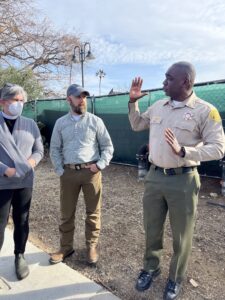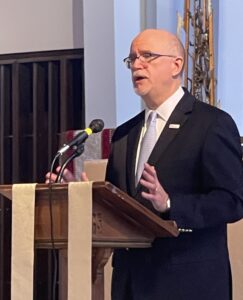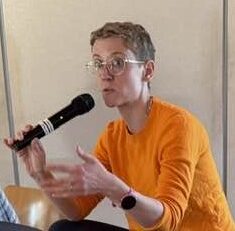Meeting with church leaders hardest hit by the Palisades and Eaton fires, Episcopal Relief & Development (ERD) President/CEO Rob Radtke and colleagues visited the Diocese of Los Angeles Jan. 31-Feb. 3, offering resources for disaster response and resiliency.
Bishop John Harvey Taylor and the Rev. Canon Melissa McCarthy, diocesan canon to the ordinary, welcomed Radtke and the ERD team, expressing gratitude for ERD’s immediate and forward-looking support, Taylor said during a Feb. 1 gathering hosted by the Church of Our Saviour, San Gabriel.
The bishop underscored particular focus on continuing care for “hardest hit neighbors, including domestic, restaurant, and undocumented workers.”
Highlighting disaster-response best practices, the forum was led by Lura Steele, ERD program officer for U.S. disaster programs, and followed a Friday-afternoon visit led by McCarthy and Sheriff’s Dept. Capt. Jabari Williams through burned areas of Altadena, including destroyed campus of St. Mark’s Episcopal Church.
Also joining the visit were Eric Weaver, ERD director of global disaster response and resilience, and the Rev. Mark Dibelka, missioner for disaster resilience of the Diocese of Northern California, a region also affected by wildfire disasters in recent years.
Preaching during Sunday-morning services at St. Augustine by-the-Sea Episcopal Church in Santa Monica, Radtke brought a message of empathy and hope to those affected by fire in Pacific Palisades, where an estimated 75% of members of St. Matthew’s Episcopal Church lost their homes.
The Santa Monica church is welcoming parishioners and school family members of St. Matthew’s to attend services at St. Augustine by-the-Sea until it is possible to return to the Palisades campus.
“Finding hope can be hard in the aftermath of a tragedy of this scale, but by God’s grace and with the love and support of your siblings in Christ throughout The Episcopal church, the diocese is beginning the long journey to recovery,” Radtke noted. “Episcopal Relief & Development will be with you as you make that journey.”
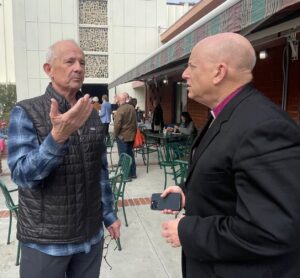
Jim Huser, parishioner and school board member at St. Matthew’s, speaks with Bishop John Harvey Taylor. Photo: Bob Williams
Radtke concluded his sermon with a metaphor of mending a shattered heirloom lamp with the Japanese “kintsugi” method, “using gold or silver along the seams of broken pieces to re-assemble the object. The result is a beautiful new work of art showing the flaws…. It’s an acknowledgement that when something is destroyed or broken, something beautiful can emerge in time,” he said. “It takes hope, imagination, and cannot be rushed.”
Since the fires broke out, Radtke, Steele and other ERD team members have been consistently working with the diocese and regularly attending meetings with diocesan leaders and clergy.
“The Episcopal Church has been in Altadena and Pasadena long before the fire and will remain,”
Steele said. “Episcopal Relief & Development will walk with the diocese as you navigate recovery.”
When the fires broke out, ERD gave the diocese a $20,000 emergency grant to support vulnerable populations affected by the fire disaster. Subsequently, ERD has raised additional thousands of dollars that will fund grants to address recovery priorities identified within communities impacted by the Palisades and Eaton fires.
The group discussed the destruction they saw on the tour, as well as the path towards rebuilding and the support of The Episcopal Church and ERD.
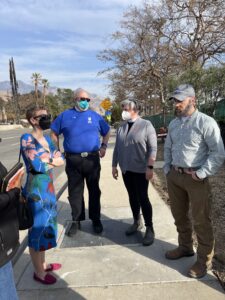
(From left) Lura Steele, Mark Dibelka, Melissa McCarthy, and Eric Weaver outside St. Mark’s, Altadena. Photo: Rob Radtke
“Disaster is never a competition,” said Dibelka, who has seen many disaster sites in his role at the Northern California diocese. “We all suffer and we all survive, and we do our best to help each other. Coming from a neighboring diocese, that’s all I can offer now.”
“It was so helpful to see the burn area and to hear from Captain Williams about his experience with the fire, how it moved through Altadena, and the challenges that are ahead for the whole community,” McCarthy said.
–Mostyn Trudinger-Smith reported from Altadena; Bob Williams reported from Santa Monica and San Gabriel.

